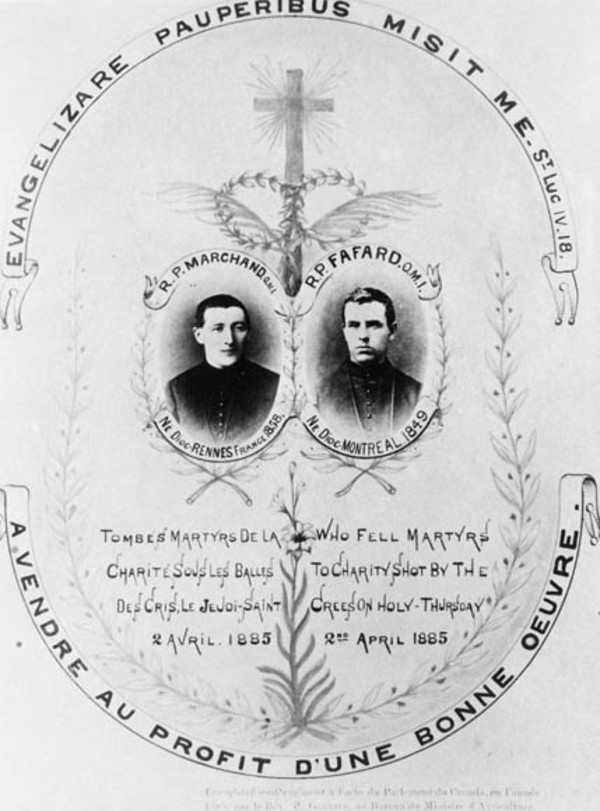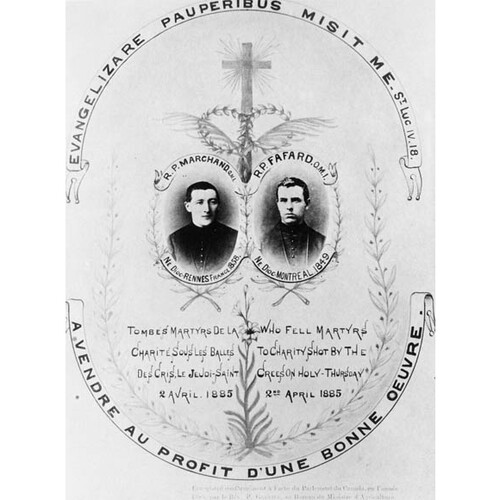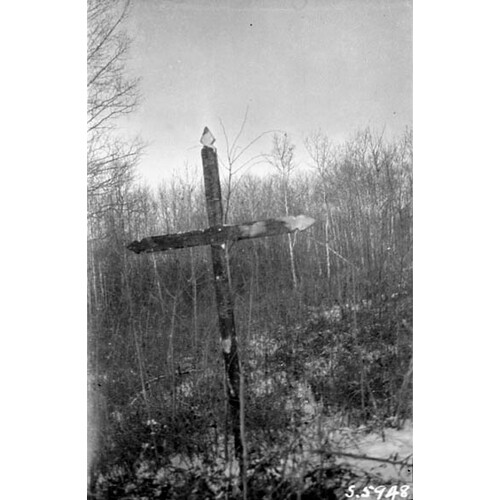FAFARD, LÉON-ADÉLARD (baptized Léon-Dollard), Oblate of Mary Immaculate, priest and missionary; b. 8 June 1850 at Saint-Cuthbert, Canada East, son of Dr Charles Fafard and Tersile (Alexine) Olivier; d. 2 April 1885 at Frog Lake (Alta).
Léon-Adélard Fafard studied at the Collège de L’Assomption from 1864 to 1872. After a year’s noviciate with the Oblates at Lachine, which ended on 27 June 1873, he took his perpetual vows on 29 June 1874. Recruited by Father Albert Lacombe* to serve in the west, he arrived on 5 Sept. 1875 at the Saint-Albert mission (Alta) where he was ordained subdeacon on 21 September, deacon on 30 November, and priest on 8 December. A week later he was sent to the Buffalo Lake mission (Alta), a wintering post for Métis coming from distant points to hunt buffalo. He spent the remainder of the winter there before returning to Saint-Albert; he went back to Buffalo Lake on 30 Oct. 1876. The buffalo having vanished from the Canadian prairies, this mission was now abandoned, and on 4 July 1877 Vital-Justin Grandin*, the bishop of Saint-Albert, sent Fafard to found the mission of Saint-Alexandre-de-Rivière-qui-Barre on Lake La Nonne (Alta), where he built a combined house and chapel. He returned to Saint-Albert, then set off with his superior, Jean-Marie-Joseph Lestanc, for Fort Pitt (Sask.); they arrived in August and established the Saint-François-Régis mission among the Woodland Crees.
Fafard accompanied Métis groups on their buffalo hunt during the summer and autumn of 1878 and 1879. When these expeditions proved disappointing he tried to persuade the Métis to turn to raising crops and livestock, even setting an example by tilling the soil at Saint-François-Régis, but he had little success with the Métis. Fafard and Lestanc spent the winters visiting the mission’s outposts. In addition they attempted to pacify the disgruntled and restless Métis and Indians, who, given the federal government’s lack of response to all their requests for help, were facing starvation.
Having worked for six years at Fort Pitt, Fafard moved to Frog Lake on 5 May 1883. He had probably foreseen that Fort Pitt would soon be abandoned: by Treaty no.6, signed in 1876, the Crees had been granted reservations some distance away, and so the importance of Fort Pitt had diminished. On 10 Aug. 1883 Fafard was appointed superior of the Frog Lake mission, as well as of those at Long and Onion lakes. He settled at roughly the spot where Abbé Jean-Baptiste Thibault* had chosen to build a hut with a mansard roof in 1843. The unpretentious residence at Frog Lake also served as a school, where Fafard, while undertaking numerous other tasks, taught some 20 pupils. A log church, well, shed, and stable were added nearby. In the autumn of 1883, as Fafard’s work-load was becoming too heavy, Félix-Marie Marchand was appointed his assistant. Marchand remained with him until October 1884 in order to learn the Cree language and run the school. He was then sent to Onion Lake to build a permanent mission; he returned to Frog Lake late in March 1885, bringing some Indians from Onion Lake to take part in the religious ceremonies of Holy Week.
At that time there was a concentration of three bands of Woodland Crees on the reservation at Frog Lake Big Bear [Mistahimaskwa], the great chief of the Plains Crees, and some 20 families came to settle there also, although they did not officially belong to the reservation. On 31 March, five days after Louis Riel’s victory at Duck Lake (Sask.), and despite warnings of serious danger, the whites and the Métis at Frog Lake expressed their unwillingness to take refuge at Fort Pitt and Fafard categorically refused to leave his flock. Emboldened by the victory of Riel’s Métis, Big Bear’s men, under the leadership in particular of their war chieftain, Wandering Spirit [Kapapamahchakwew], decided to follow the Métis example and take the offensive. On 2 April they burst into the church at Frog Lake during a Maundy Thursday service. Wandering Spirit ordered the people of the mission to accompany him to Big Bear’s camp. Fafard and Marchand marched at the head of the column, praying as they went. Thomas Trueman Quinn, the Indian agent, refused to follow and was shot. The result was an outburst of violence. Charles Gouin (a Métis), John Williscroft, John Gowanlock, and John Delaney were killed. Responding to Theresa Delaney’s cry for help, Fafard ran to grant absolution to her husband. He had scarcely finished when he was mortally wounded by a bullet; Marchand, William Gilchrist, and George Dill suffered the same fate.
Some Métis placed the bodies of the two missionaries and of Gowanlock and Delaney in the burial vault of the church. Subsequently interred in the cemetery, the bodies of the priests were transferred in 1891 to the cemetery of the new mission opened at Onion Lake in 1887 and finally, many years later, were buried in the Oblate cemetery at Saint-Albert.
[V.-J. Grandin], “Les martyrs du Nord-Ouest: lettre de Mgr Grandin au père et à la mère du R. P. Fafard, martyrisé au lac La Grenouille,” Missions de la Congrégation des missionnaires oblats de Marie Immaculée (Paris), 23 (1885): 417–30. [Hippolyte Leduc], [“Lettres au révérend père Aubert”], Missions de la Congrégation des missionnaires oblats de Marie Immaculée, 16 (1878): 465; 22 (1884): 24. Allaire, Dictionnaire. W. B. Cameron, The war trail of Big Bear . . . (Toronto, 1926), 13. Jules Le Chevalier, Batoche, les missionnaires du Nord-Ouest pendant les troubles de 1885 (Montréal, 1941), 99, 101–19. A.-G. Morice, Histoire de l’Église catholique dans l’Ouest canadien du lac Supérieur au Pacifique (1659–1915) (3v., Winnipeg et Montréal, 1912), III: 78–88. Théophile Ortolan, Cent ans d’apostolat dans les deux hémisphères: les Oblats de Marie Immaculée durant le premier siècle de leur existence (4v., Paris, 1914–32).
Cite This Article
E. O. Drouin, “FAFARD, LÉON-ADÉLARD (baptized Léon-Dollard),” in Dictionary of Canadian Biography, vol. 11, University of Toronto/Université Laval, 2003–, accessed April 26, 2025, https://www.biographi.ca/en/bio/fafard_leon_adelard_11E.html.
The citation above shows the format for footnotes and endnotes according to the Chicago manual of style (16th edition). Information to be used in other citation formats:
| Permalink: | https://www.biographi.ca/en/bio/fafard_leon_adelard_11E.html |
| Author of Article: | E. O. Drouin |
| Title of Article: | FAFARD, LÉON-ADÉLARD (baptized Léon-Dollard) |
| Publication Name: | Dictionary of Canadian Biography, vol. 11 |
| Publisher: | University of Toronto/Université Laval |
| Year of revision: | 1982 |
| Access Date: | April 26, 2025 |







